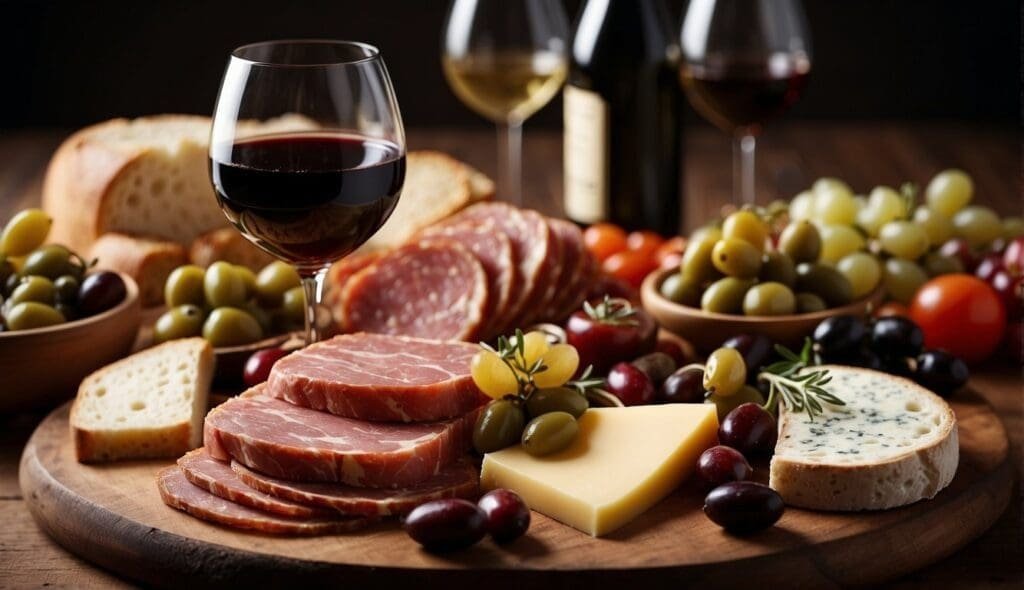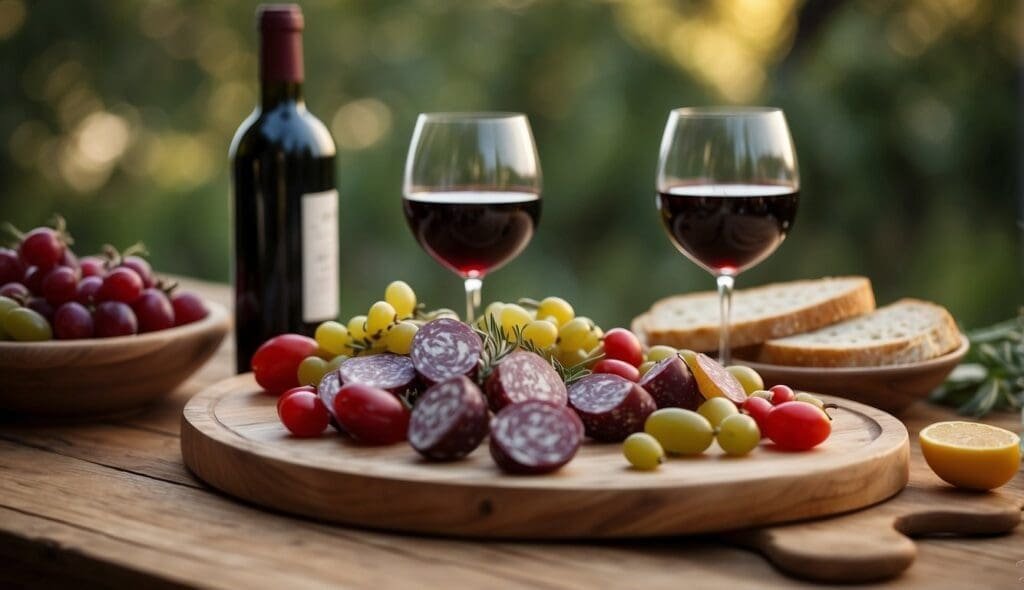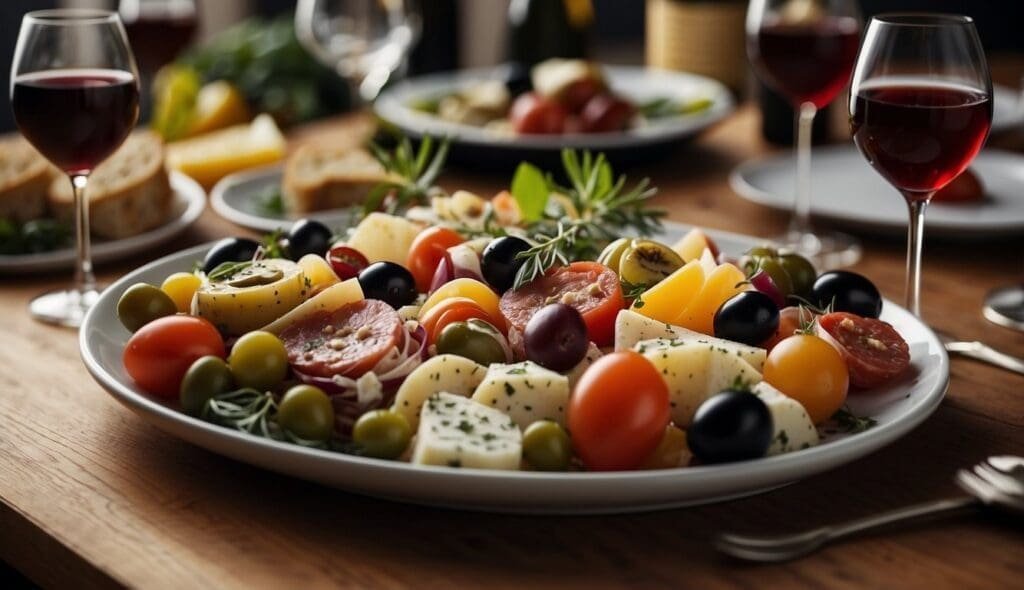This post may contain affiliate links. Please read my disclosure policy.
Crafting the perfect antipasto platter is an art, and pairing it with the right wine can elevate your dining experience to new heights. When you prepare an array of delicious starters like cured meats, cheeses, and pickled vegetables, you’re setting the stage for a delightful meal.
The key to a successful wine pairing with antipasto is to consider the textures and flavours on your platter and match them with a wine that complements or contrasts those qualities, enhancing the taste of both the food and the wine.

Wine pairing is not just about red with meat and white with fish anymore. With antipasto, you have a spectrum of taste profiles to consider. From the saltiness of olives to the rich creaminess of brie, each component can be thoughtfully paired with a wine that echoes or balances its flavour. If your antipasto includes bold, savoury items, a moderately acidic red wine may be just the choice to cleanse the palate. For lighter and fresher antipasto components, a citrusy white could be the perfect match.
The goal is to create a dining experience where the wine and the antipasto support one another. When done right, every sip of wine and every bite of food is a mini-celebration of culinary harmony. So, pour yourself a glass, arrange your best antipasto selection, and prepare for a journey through Italy’s beloved tradition of small, yet sumptuous, starters.
Foundations of Wine Pairing with Antipasto

Exploring the rich tradition of Italian antipasto and its wine pairing is more than a culinary journey; it’s an art form. You’ll find a harmonious blend between the robust flavours of antipasto components and the enhancing attributes of various wines.
Understanding Antipasto
Antipasto, meaning “before the meal,” is an assortment of flavourful appetisers. Its purpose is to stimulate your appetite without filling you up. Typical ingredients include olives, various meats such as prosciutto, a range of cheeses, tomatoes, artichokes, and olive oil.
Principles of Wine Pairing
The key to wine pairing is finding a balance where wine complements the food. It involves considering the taste, acidity, texture, and sweetness of both the food and the wine.
Selecting the Right Wine
When selecting wine, consider the dominant flavours on your antipasto platter. For salty items like provolone or soppressa, a prosecco with its spritzy acidity can be a delightful choice.
Food Components and Wine Interaction
Each food’s taste and texture—whether sweet, salty, or acidic—will interact differently with wine. Chianti can complement hard cheeses and cured meats, cutting through the fat with its own acidity.
Combining Textures and Flavours
The goal is to either complement or contrast textures and flavours. A creamy mozzarella might pair well with a light sauvignon blanc, while a pinot noir could bring out the best in both tomatoes and basil.
Role of Freshness and Aging
Fresh ingredients like tomatoes and basil go well with youthful wines, whereas aged parmigiano reggiano can stand up to the complexity of an older red wine.
Classic Antipasto Ingredients
Key ingredients on a traditional platter include artichoke hearts, pickled peppers, olive oil-drizzled bread, mozzarella, and a variety of meats.
The Art of the Antipasto Platter
Assemble your platter with a mix of textures and tastes: pair soft cheeses and fruits with crisp white wines like chardonnay, while hard cheeses and cured meats find their match in full-bodied red wines like sangiovese or lambrusco.
Guiding Principles for Various Antipasto Types

Antipasto, the traditional Italian starter, can be as varied as the wines you may choose to accompany them. The key is to match the intensity of the flavours in your antipasto with the right type of wine.
Traditional Italian Antipasti
For a classic Italian antipasto, think about how the vibrant flavours from items like olives, marinated vegetables, and prosciutto interact. A light and zesty Pinot Grigio complements the saltiness and brings out the essence of the olive oil drizzled on top. If your platter features hard cheeses such as Parmesan, a Chianti with its robust notes might be a fitting choice.
Cheese-Led Antipasto Pairings
With cheese at the forefront, consider the texture and level of creaminess. Soft cheeses like ricotta or burrata beg for a bright, acidic wine like Sauvignon Blanc that cuts through the richness. Conversely, pungent cheeses such as gorgonzola and taleggio are beautifully paired with a sweeter wine; a drizzle of honey on the cheese can align nicely with an off-dry Riesling.
Meat-Focused Antipasto Elements
When meats take center stage in your antipasto, like slices of salami, bresaola, or soppressa, look for a wine with enough heft to stand up to these bold flavours. A light-bodied red, such as a Dolcetto, mirrors the delicacy of cured meats without overpowering. For heavier items, like chunks of ham, a bolder Barbera can support the fat and salt of the meat.
Seafood and Vegetarian Antipasto Options
For antipasti that feature seafood or remain strictly vegetarian, your wine choice should enhance the delicate flavours without overshadowing them. A zippy Vermentino works wonders with marinated artichokes or a fresh seafood salad. Pickled vegetables, on the other hand, are well-suited to a sparkling Prosecco, which can cleanse the palate and balance the acidity.
Serving and Presentation Tips

Crafting an exquisite antipasto experience involves more than just selecting fine cheeses and charcuterie. The presentation of your platter and the service of your wine are equally critical to delight your guests.
Assembling the Perfect Antipasto Platter
When assembling your antipasto platter, consider a variety of textures and flavours. Start with a classic wooden or slate board to add a rustic appeal. Arrange a mix of cured meats, cheeses, and fresh produce in a circular fashion to maximise accessibility and visual impact. Remember, a well-crafted platter serves as the centrepiece of your gathering.
Accompaniments and Garnishes
Alongside the staples of your antipasto, include an assortment of crackers, almonds, and walnuts for crunch. Honey and olive oil can be drizzled over for a hint of sweetness and richness. Fresh herbs like basil, lemon zest, and rosemary act as garnishes that complement the overall taste profile and add a vibrant touch to the platter.
Wine Serving Tips
The right wine pairings can elevate your antipasto platter. Serve Prosecco chilled to refresh the palate before delving into richer foods. Offer a variety of red and white wines at the appropriate temperature, considering that full-bodied reds should be slightly cooler than room temperature and whites chilled. Use proper glassware to accentuate the wine’s aroma and flavour, enhancing the entire tasting experience.
Conclusion

When selecting a wine to compliment your antipasto, aim for harmony between the flavours of the dish and the wine’s characteristics. For a Tuscan-inspired platter, a bottle of Chianti, known for its fruity notes and rustic charm, will transport you and your friends or family to the rolling hills of central Italy.
- Red wines with moderate acidity balance the saltiness and richness of cured meats.
- White wines with a crisp profile cut through the heaviness of cheeses.
- Sparkling wines add a festive touch and cleanse the palate between bites.
An antipasto meal is more than just a starter course; it sets the stage for an enjoyable dining experience. So, whether you’re crafting a simple dish for a quiet night in, or a lavish spread for a gathering, remember these pairings:
- Salami | Bold Reds
- Olives | Dry Whites
- Cheeses | Medium-bodied Reds or Crisp Whites
Embrace these guidelines with confidence, ensuring your culinary creation is met with delight. By pairing thoughtfully, each sip and bite will enrich the moment, making your shared meal a memorable one.
Frequently Asked Questions
Navigating the subtleties of wine and antipasto pairings can elevate your dining experience. Here are answers to common queries to help you select the perfect wine.
What varieties of red wine enhance the flavours of an antipasto platter?
Medium-bodied red wines, like a Chianti or Pinot Noir, pair well with the rich and varied flavours of an antipasto platter. Their balanced acidity cuts through the savoury umami of cured meats, enhancing each bite.
Which white wines would you recommend to complement an antipasto selection?
For antipasto selections that include seafood or lighter fare, a crisp Pinot Grigio or a zesty Sauvignon Blanc will match well, their acidity and citrus notes providing a fresh contrast to the saltiness of the dishes.
Can you suggest the best pairing for a wine and antipasto evening?
A versatile and flavourful wine like Lambrusco, which can be slightly sparkling and chilled, is excellent for an array of antipasto items. Its bright character is amiable in the company of both rich and subtle flavours.
What type of wine should be served alongside antipasto and an assortment of cheeses?
When cheeses are involved, opt for a wine that complements the specific variety. A robust Shiraz goes well with aged cheeses, while a creamy Brie might call for a buttery Chardonnay to match its richness.
How do Italian appetisers typically influence the choice of wine pairing?
Italian appetisers often feature bold flavours like garlic, tomato, and basil. A wine with good acidity, such as Sangiovese, can complement and elevate these flavours without overpowering the food.
Are there specific wines that are known to pair well with both olives and other antipasto components?
Olives, with their briny and slightly bitter taste, fare well with wines that offer a fruit-forward profile with some herbal overtones, such as a Vermentino or Grenache, to balance the dish’s saltiness and acidity.
User Review
( votes)Sip smarter, subscribe now!
Subscribe for gourmet tips, event updates, travel ideas, and a free e-book on Food Pairings. Start your journey to culinary and travel excellence!













